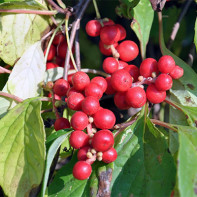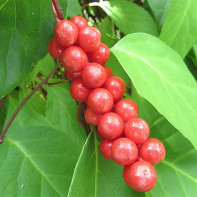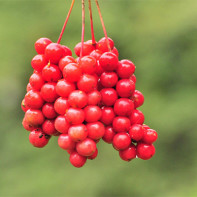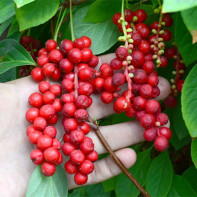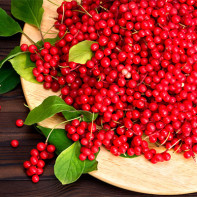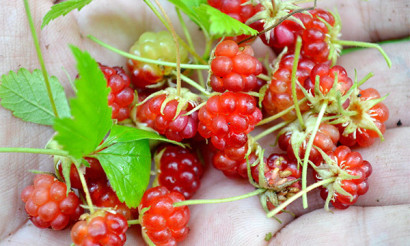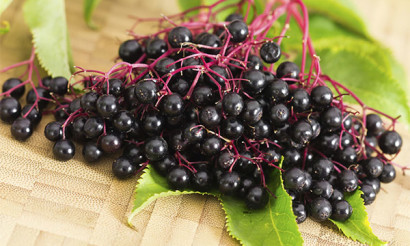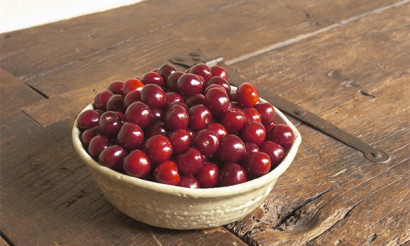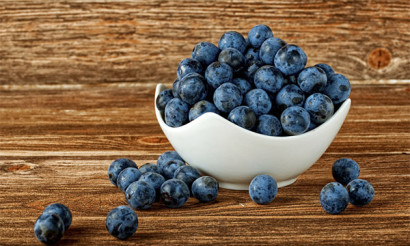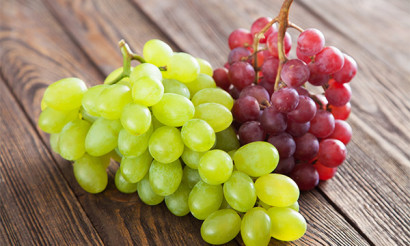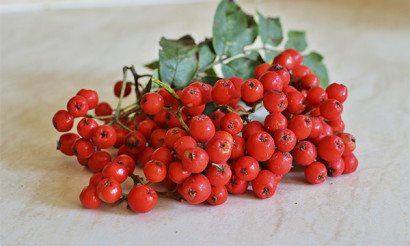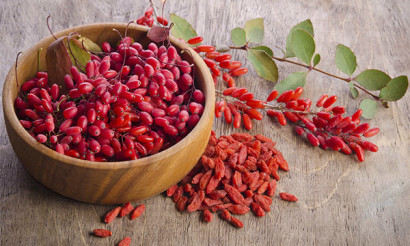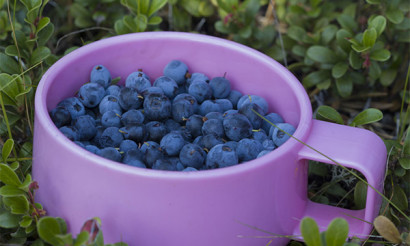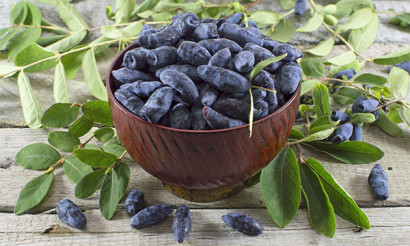Schisandra: health benefits and harms
Schisandra chinensis or Far East is a schizander family vine that has nothing to do with lemon except the characteristic citrus smell, which exudes all parts of the plant.
- What does lemongrass look like and where does it grow
- Botanical characteristics
- Kinds
- Composition and calorie content
- Useful properties of lemongrass
- General benefit
- For women
- For men
- During pregnancy
- When breastfeeding
- For kids
- When losing weight
- Useful properties of lemongrass leaves
- The use of tincture of lemongrass
- The benefits of lemongrass juice
- What is useful lemongrass syrup
- Is lemongrass tea useful
- Schisandra oil: properties and applications
- Useful properties of lemongrass seeds
- The use of lemongrass in traditional medicine: recipes
- Schizandra tonic wine
- Fresh Sugar Berries
- Seed tincture
- Schisandra in cosmetology
- For face
- For hair
- Cooking Application
- Lemongrass jelly
- Stewed lemongrass berries
- Schisandra with honey
- Harm and contraindications
- How to collect and store lemongrass
- How to dry
- How to brew lemongrass
- Berry tea
- Leaf tea
- Tea with lemongrass and wild rose
- Green tea with lemongrass
- How to make lemongrass jam
- Jam from lemongrass berries
- Jam from berries of lemongrass with apple juice
- Interesting facts about lemongrass
The medicinal properties of lemongrass have been known for a long time. In a Chinese treatise on medicinal plants in 1596, lemongrass is given a place next to ginseng. Hunters of the Amur Region, golds, to restore strength during long crossings in the taiga, ate fresh and dried lemongrass berries.
What does lemongrass look like and where does it grow
Botanical characteristics
Schisandra is a beautiful deciduous vine with a dark brown trunk and large oval leaves.

The trunk of the plant is very strong, thin - does not exceed 3 cm in diameter, the perennial part is covered with dark rough bark, annual shoots are light yellow and smooth. A long liana (up to 15 m) encircles trees and artificial supports in a spiral.
Large elliptical leaves are dark green and smooth on the front side, paler and covered with a weak fluff from the inside. They are attached to the shoots with the help of pinkish-red petioles 2-3 cm long; in the autumn they turn yellow and fall off.
An inflorescence of 3-5 buds is located in the axils of the leaves of one-year shoots. Blooms for 1.5–2 weeks in mid-June with small (1.5 cm in diameter) white flowers that acquire a pinkish tint by the end of flowering.
Schisandra belongs to monoecious plants - on one specimen there are dioecious flowers. There are no stamens in the female type flowers, this is their main difference from the male ones. The sex ratio on one vine depends on weather conditions.
The fruit, multi-berry, is formed from a female flower. The shape resembles a bunch of small berries of irregularly-rounded shape weighing 0.5-0.7 g. The length of the petiole is up to 5 cm, the berries in the brush are up to 20 pieces, the average weight is 5-7 g.
There are 1-2 yellow-brown kidney-shaped seeds in the berry. Seeds are easily separated from the pulp. 1000 seeds weigh 17–20 g.
Reddening of berries begins in the second half of August; full ripening occurs in September. The taste of berry juice is sour with lemon aroma, the skin is dense with a bitter taste. Seeds make a sharp pepper note in the gamut.
The taste of berries Professor A.P. Nechaev described as bitter-sour-sweet-tart-salty. The Chinese name of lemongrass "W-wei-tzu" is translated as "the fruit of five tastes." The brushes hold tight on the shoots until winter.
Kinds
The species abundance of the schizander family is not precisely determined and, according to various sources, combines from 14 to 25 species. Habitat - Asian countries: Vietnam, China, Korea, India, Burma, Japan.
In Russia, there is one representative of this family - Schisandra chinensis or Far East. Before the ice age (1.8 million years ago), this relict liana was widespread in the middle latitudes of the Northern Hemisphere.Currently, it is an endemic species of taiga forests of the Primorsky Territory and Amur Region. It grows on river banks and hillsides, preferring cedar-broad-leaved forests of the Manchurian type with well-drained soil.
In addition to the fact that all parts of this plant have a powerful healing effect, the vine is very beautiful in any season. Even in winter, brushes of bright scarlet berries look spectacular against the background of snow. Therefore, it is strange that domestic breeders drew attention to this taiga miracle only in the early 80s. The first variety “Firstborn” was included in the State Register of Breeding Achievements in 1999.
Now there are 4 such varieties:
- Firstborn (1999).
- Myth (2011).
- Volgar (2011).
- Debut (2013.)
The biggest fruits are Debut. The berries in this variety have the highest concentration of sugar (4.3%) and vitamin C (9.7%). Record holders for productivity - Myth and Volgar.
All 4 varieties grow well in the middle lane.
Composition and calorie content
The bulk of fresh lemongrass berries is water - 85%. The remaining 15% of dry matter includes:
- 27-30% of organic acids (citric, malic, tartaric and succinic);
- 20% sugar;
- 4% pectin;
- 1% tannins;
- 0.8% of substances with P-vitamin activity;
- 0.25% ascorbic acid (vitamin C).
1.15% ash containing macro- and microelements:
- potassium;
- phosphorus;
- magnesium;
- copper;
- calcium;
- manganese;
- nickel;
- titanium;
- molybdenum;
- lead;
- tin;
- zinc.
Schisandra seeds contain:
- 30–34% of unsaturated omega fatty acids (mainly oleic and linoleic);
- 2% essential oil;
- 0.12% lignans (phytohormones);
- 0.03% vitamin E;
- ash - the same micro and macro elements as in berries.
The stimulating, exciting and tonic effect of the phytohormone contained in lemongrass seeds was discovered by the Soviet scientist D.A. Balandin. He gave him the name "schizandrin" - from the Latin name for this creeper Schisandra chinensis - schisandra or schisandra.
The bark is rich in essential oils with a delicate spicy-lemon aroma, for which perfumers so value it.
The total calorie content of 100 g of lemongrass berries is 11.6 kcal. The daily dose of berries necessary to meet the adult's need for vitamin C is 50 g, i.e. 5.8 kcal or 0.5% of the daily norm.
Useful properties of lemongrass
General benefit
Schisandra was held in high esteem by Chinese healers. According to its healing properties, miracle creeper was put in second place immediately after ginseng. Schizandra received such recognition due to the high content of vitamins and minerals in all parts of the plant.
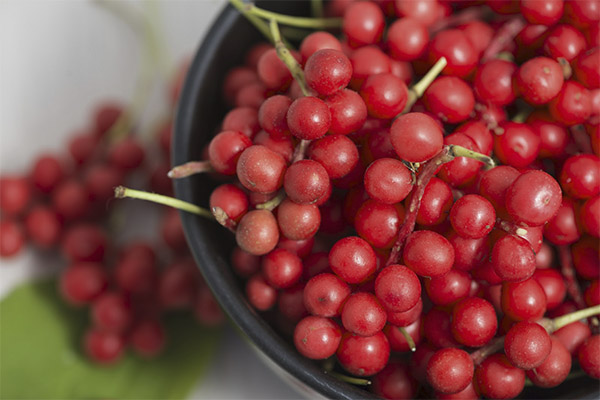
- The main character and warrior with ailments and a bad mood is schizandrin. This phytohormone enhances the processes of excitation in the central nervous system, aggravates reflexes, tones up and helps to cope with increased loads, both physical and psychoemotional.
- Schizandrin increases the excitability of the central nervous system and stimulates the work of the heart and respiratory apparatus. It is a natural stimulant with a powerful adaptogenic effect.
- Reception of tinctures from berries or just chewing leaflets of the Far Eastern creeper allows you to adapt (adapt) to physical, mental and psychological stress during an exam, competition or a heavy night shift.
- Vision is sharpened, including night vision - this quality was especially appreciated by hunters. During the Great Patriotic War, lemongrass berries were included in the mandatory diet of pilots.
- Preparations of Chinese magnolia vine are prescribed for asthenic syndrome, during the recovery period after severe infectious diseases, with vegetovascular dystonia.
- Schizandrin and schizandrol also exhibit hepatoprotective activity, i.e. they protect the liver from the effects of adverse factors and dietary disorders.
- Schisandra is indicated for sexual dysfunction, which developed against the background of neurasthenia.
- A decoction of fruits is used to lower blood sugar.
- 2 g of seed powder, taken even once, normalize the composition of the gastric juice - reduce high and increase low acidity.
For women
The composition of lemongrass includes plant hormones - phytoestrogens, which maintain the hormonal balance in women during menopause and during PMS. The tincture of berries and lemongrass essential oil will support the wonderful representatives of humanity in this difficult period of their lives - they will remove irritability and help fight against depressive mood.
For infertility and ovarian problems, a 3-week course of treatment with alcohol tincture of berries is recommended - 15 drops twice a day.
With inflammation of the appendages, a decoction of lemongrass with herbs will help. The biostimulants in it stop the inflammation, strengthen immunity, and improve mood.
In equal proportions mix:
- fruits of lemongrass and chestnut;
- plantain leaves and lingonberries;
- St. John's wort grass;
- ginseng root and lure.
Grind and pour 2 tbsp. prepared raw materials with 2 cups boiling water. After 30 minutes, strain. For a month, drink 150 ml of the drink before meals three times a day. Cook the broth daily.
For men
Schisandra chinensis is a natural aphrodisiac that increases potency. Therefore, lemongrass tincture can be used to treat sexual dysfunction in men as an alternative to medications.
One of the causes of decreased potency is inflammation of the prostate. In this case, the tincture of lemongrass stops the inflammation, strengthens the immune system and reduces anxiety and depression.
Obesity is the second reason for a decrease in potency. The polysaccharides present in the tincture help to cope with this problem. They contribute to the rapid conversion of food into energy, preventing fat deposits from forming.
The third cause of erectile disorder is stress. Schizandrin, which is part of the seeds of Schisandra berries, will relieve psychoemotional stress and improve mood.
Lemongrass tincture to increase potency can be prepared with vodka or water. In the first case, the therapeutic dose will be 30 drops three times a day, in the second - half a glass 2 times a day.
During pregnancy
The use of lemongrass-based drugs during pregnancy should be treated very carefully:
- carefully examine the list of contraindications in this article;
- be sure to get advice from a gynecologist;
- take the drug only after approval by the supervising doctor.
In the absence of contraindications, you can take lemongrass syrup. It alleviates the symptoms of toxicosis, raises pressure during vegetative-vascular dystonia and in asthenia after pathological birth and abdominal operations.
When breastfeeding
Taking any lemongrass preparations during breastfeeding is not advisable, so as not to provoke an allergy in the newborn.
You can use lemongrass berries syrup as a prophylactic during flu outbreaks. But in this case, it is important to closely monitor the skin condition of the child and his behavior.
For kids
Pediatricians do not recommend the use of lemongrass for the treatment and prevention of diseases in children under 12 years of age.
After reaching this age and in the absence of contraindications, children can introduce jam or syrup from the magnolia vine berries into the diet:
- For the prevention of viral diseases. The likelihood of picking up the flu will decrease by 4 times.
- Treatment of dysentery.
- Smoothing out stress and toning during exams or sporting events.
When losing weight
Reasons for gaining excess weight:
- lethargy and apathy, leading to a sedentary lifestyle;
- craving for high-calorie and sweet foods;
- metabolic failure.
Lignans (schizandrin and schizandrol), which are part of lemongrass seeds, transfer the body to a different mode of operation, providing stimulating and tonic effects. As a result of the action of these phytohormones, normalization of metabolism and metabolism occurs, a person feels alert and active.
Preparations based on lemongrass can be prepared by yourself or purchased at a pharmacy. The ability of lemongrass to accelerate metabolic processes does not depend on the form of the drug, so choose based on your preferences: seeds, berries, tablets, syrup, vine.
Take at breakfast and lunch in the following doses:
- fresh or dried berries - 5-6 pieces;
- alcohol tincture - 25-30 drops;
- berry juice or a decoction of bark - 1 tsp
Observe the dosage to avoid health troubles - headache, allergic rashes, high blood pressure and insomnia.
Do not use lemongrass in the afternoon because of its tonic effect.
Useful properties of lemongrass leaves
The vegetative parts of creepers (leaves, stems and bark) contain fewer tonic substances than fruits, and therefore act on the body softer.
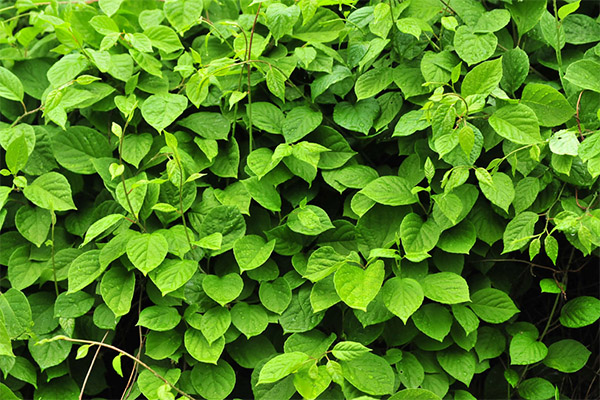
It is very useful to chew fresh green leaves of lemongrass. 1-2 leaves will be enough to feel a surge of strength.
Dried leaves can be used to brew vitamin and tonic tea. Schisandra leaves can be used alone or as part of a drug collection. The benefits of leaf tea are described earlier in this article.
Information on how to properly collect and dry leaves will be given below in the chapters "When to Collect and How to Store Schisandra" and "How to Dry Schisandra."
The use of tincture of lemongrass
Tincture of lemongrass from fresh and dried berries relieves fatigue, invigorates, whets the appetite and puts the immune system on alert. It is used to prevent acute respiratory viral infections, increase tone and treat nervous exhaustion.
Below are 2 recipes for preparing tinctures:
- From fresh berries. Pour the berries with 70% alcohol in a weight ratio of 3: 1. Put in a dark place for a day. Before use, dilute 20 drops of tincture in 50 ml of water. Take three times a day half an hour before meals, but no later than 6 hours before bedtime.
- "Strong." Crush 20 g of berries in a porcelain or ceramic mortar. Do not use metal utensils. Place the berry gruel in a container of dark glass and pour 100 ml of 70% alcohol. Insist by shaking occasionally. After 10 days, squeeze through cheesecloth. After 2 days, tincture can be consumed in the morning on an empty stomach in 30 drops for 3 weeks.
The benefits of lemongrass juice
Juice of lemongrass berries is used in cooking to give a citrus aroma, astringent taste and tonic effect to drinks and syrups. Add it to the filling for sweets, and jelly, and jam. In winemaking, it is used for blending wines.
Juice is useful for gastritis with low acidity. 1 tbsp a day taken before breakfast and lunch will help to cope with this problem.
Juice is made from freshly picked berries. Keep the berries in the refrigerator for a day to soften. Then squeeze the juice using a press, making sure that the crushed seeds do not fall into the juice, as they will give it a gummy flavor. Dissolve sugar in the resulting juice in a ratio of 1: 2, pour into a container of dark glass. Store this juice in a cool place for 2.5–3 years.
To strengthen the immune system, it is recommended to drink juice diluted twice with mineral or ordinary water.
What is useful lemongrass syrup
Processing berries in the preparation of syrup does not reduce the beneficial properties inherent in this plant.
- Syrup is recommended for use in case of loss of strength, headaches, upset stomach.
- Phosphorus, which is part of berries and seeds of schisandra, sharpens vision, including night.
- The syrup is indicated for use by people with vegetovascular dystonia and asthenic syndrome, as it can increase pressure.
- For colds, syrup is used as an expectorant, which improves sputum discharge.
- Syrup is taken as a general strengthening agent, adding to various drinks.
- It helps to cope with a hangover syndrome due to its tonic and mild analgesic effect.
- In case of an infectious disease of the kidneys, the antimicrobial property of the syrup helps to eliminate the focus of inflammation and quick recovery.
- Syrup is also indispensable in the diet of people who monitor their weight.
Is lemongrass tea useful
Tea from leaves and schisandra bark has long been used against scurvy. The drink tastes good and has a refined aroma.
In ancient China, tea from lemongrass was drunk mainly by men, since they believed that it gives them special strength and endurance.
Schizandra tea is useful as part of a comprehensive treatment of the following diseases:
- depressive states;
- hormonal imbalance;
- bronchitis and pneumonia;
- chronic diseases of the liver and kidneys;
- stomach upset;
- vision problems;
- hypotension;
- excess weight.
Schisandra oil: properties and applications
Essential oil is found in different proportions in all parts of the vine. Most of it is in the bark and seeds.
At home, you can’t get lemongrass ether, it is produced on an industrial scale by extraction and pressing methods. Ready-made oil can be purchased at pharmacies. Release form - bottles and soluble capsules.
Essential oils from lemongrass are widely used in cosmetology and are part of tonic creams for aging skin care. They struggle with age spots and narrow pores.
Essential oil is used in the treatment of fungal skin diseases, depriving and scabies. It is effective for pediculosis, eliminates discomfort and swelling after an insect bite.
Lemongrass oil in capsules is used as an adaptogenic and restorative remedy for vitamin deficiency, exposure to extreme conditions and chronic fatigue. The use of oil increases efficiency by 4 times.
Schisandra oil in capsules is also indicated for use by schoolchildren and students during exams in order to cope with the psycho-emotional load and help to absorb a large amount of information.
It is used by athletes, because it, not being a dope, has a powerful tonic effect and mobilizes all the body's resources to achieve the goal.
Oil is taken in autumn and spring with two courses of 10 days and a 20-day break between them. With a significant loss of strength and depressed mood, the simultaneous adoption of 3-4 capsules is acceptable.
In order to make sure that you do not have contraindications for taking lemongrass oil, you must first consult your doctor.
Useful properties of lemongrass seeds
Based on lemongrass seeds, tincture and powder are prepared. Their use restores the work of all body systems, mobilizes it in extreme conditions, helps to overcome drowsiness and decreased attention. Tincture is recommended for increased gastric acidity, hypotension, decreased hearing and vision.
Receiving seed powder 1-3 g per day reduces the feeling of fatigue during significant physical exertion, for example, during night shifts. The increase in strength is felt half an hour after taking the powder and lasts up to 8 hours. Addiction does not develop. The duration of the course is 3 weeks, the maximum effect of taking the powder is observed at the end of the second week of the course.
The use of lemongrass in traditional medicine: recipes
Decoctions and tinctures of lemongrass have long been used in folk medicine. They treat various ailments: kidney disease, tuberculosis, loss of strength, slowly healing purulent wounds. They enhance visual acuity. For both women and men, these drugs return the joy of an intimate life.
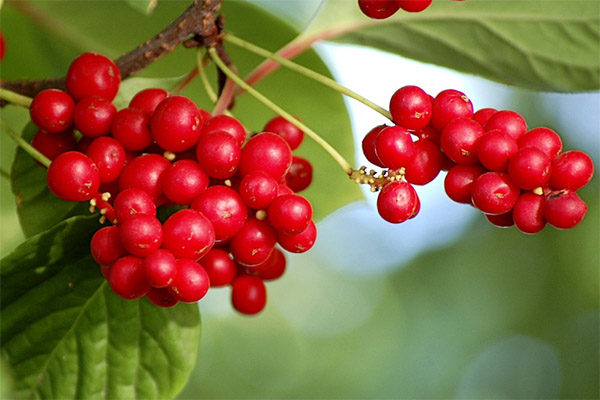
Below are some recipes.
Schizandra tonic wine
When making juice, there is a spin in which there is a lot of pulp. It can be used for making wine. First you need to extract the seeds, otherwise the wine will be bitter and have a tarry smell. Then pour the resulting mass with water. After 2-3 days, the precipitate should be drained, and sugar should be added to the must and diluted well with water. Wait until fermentation is complete. To drink in the summer in the hottest time, diluting twice with water (better than spring or well).
Fresh Sugar Berries
This is a winter harvest to maintain good shape. Sort the berries, dry on a paper napkin. Put in a jar, mixing with sugar. Take 2 times more sugar than berries. Cover the banks with parchment and tie.Store in a cool place. You can eat berries just like that or add to tea or pastries.
Seed tincture
Rinse the seeds extracted from the pulp during the preparation of the wine. Then grind them well and add 3 parts of vodka (by weight). After 14 days in a dark place, take 25 drops up to 3 times a day.
Schisandra in cosmetology
Schisandra has found worthy use in cosmetology. All its parts are used for the preparation of creams, masks, lotions and balms for hair and face.
For face
Phytohormones in lemongrass have a beneficial effect on the skin of the face. They restore skin cells, brighten it and narrow pores, making the skin velvety and elastic. Long-term use of berry juice in skin care tightens the contour, smoothes wrinkles, making the face younger.
- Anti-aging mask. A mixture of 1 tsp pulp of lemongrass berries and 2 tbsp. Sour cream spread evenly on the face, avoiding the area around the eyes. After 20 minutes, wash with warm water.
- Tonic for oily skin. To 0.5 l of alcohol infusion of lemongrass berries, prepared according to a standard recipe, add a tablespoon of glycerin. Mix. In a separate container, dilute with water 4 times and wipe the face in the morning and evening.
- Mask for dry skin. K 2 tbsp oily sour cream add 1 tbsp. pulp from the fruits of lemongrass. Stir and apply on face for 10 minutes. Wash off with a swab dipped in medium-fat milk.
For hair
Conditioners based on infusions of Chinese lemongrass make hair shiny and prevent hair loss.
- Rinse aid for strengthening hair. 4 tbsp pour dried and chopped leaves of lemongrass with boiling water (1 l). Insist 7 minutes in a water bath. To the filtered infusion add 1 tbsp. vinegar.
- Hair conditioner with herbs. Mix in a pan for 1 tbsp. dried and chopped nettle leaves, lemongrass and chamomile pharmacy. Pour in 1 liter of water and, bringing to a boil on the stove, boil for another 5 minutes. Use after straining to rinse hair.
Cooking Application
Berries of the taiga guest are also used in cooking. Aromatic desserts with an unusual piquant taste are made from them.
Lemongrass jelly
In a heated (but not to a boil) liter of berry juice, pour 3 tbsp. pectin, set aside for half an hour. At this time, boil the syrup from 3 glasses of sugar and 150 ml of juice. Combine sugar syrup with swollen pectin and cook with stirring until thickened. Ready jelly warm pour into molds. Before serving, sprinkle with powdered sugar and cut into pieces of the desired size.
Stewed lemongrass berries
Rinse 1 kg of berries, sort through and pour into an enameled pan. Pour the berries prepared in advance from 600 ml of water and 1.3 kg of sugar syrup. Soak for 2 hours, bring to a boil and cook for 15 minutes. Pour the ready-made compote into cans and sterilize in a water bath.
Schisandra with honey
Halved berries pour honey. Keep refrigerated. Drink in the morning with tea.
Harm and contraindications
Preparations based on lemongrass have a pronounced tonic effect, therefore, before proceeding with treatment, it is necessary to consult a doctor.
Contraindications:
- individual intolerance;
- insomnia;
- increased irritability;
- epilepsy;
- hypertension;
- pregnancy;
- breast-feeding;
- hepatitis;
- intracranial pressure;
- stomach ulcer;
- violation of cardiac activity;
- acute infectious disease;
- age up to 12 years;
- consequence of severe injuries.
An overdose of lemongrass can cause insomnia, headaches or allergies. If any of the symptoms occur, stop taking the drug.
Do not use lemongrass-based drugs in the afternoon after 15 hours, as lemongrass increases tone, which can lead to insomnia.
How to collect and store lemongrass
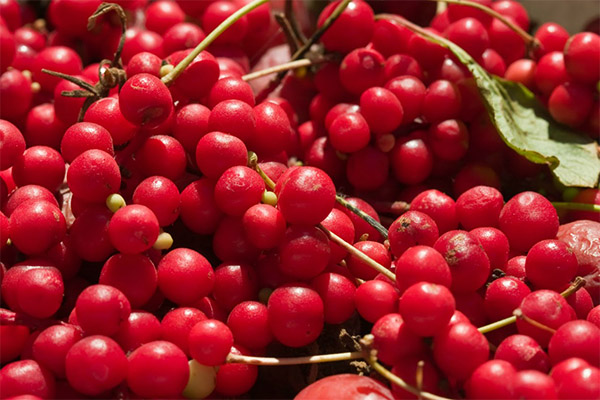
Medicinal raw materials in lemongrass are all parts of the plant:
- bark - harvested in the spring;
- vine - during the ripening period of the fruit;
- leaves for tinctures - during blooming, for mucus - during leaf fall;
- fruits - from the second half of September to the first frosts.
The knife for cutting the fruits of lemongrass should be sharp. Brushes need to be cut carefully, trying not to damage the vine. Collect fruits should be in an enameled bucket or basket.
Important! It is impossible to store berries not processed for more than a day.
It is strictly forbidden to use easily oxidized dishes during the collection or processing of berries.
How to dry
Berries
Schisandra berries are dried without removing the stem, so that the fruits do not run out of juice. They, if not very many, can be hung in the kitchen until completely dry. If the berry crop is rich, then it is better to lay them on nets or wooden boards in one layer and keep it until the berries are tightened. Then bring to condition in the oven or electric dryer.
Dried berries become hard, wrinkled and maroon. The taste is spicy, slightly bitter. To prevent mold, it is best to store them in cardboard or wooden boxes in a cool, blown place.
Leaves
Finely chop leaves and young shoots and dry in a shaded and blown place, sprinkling a thin layer on paper. You can store in cloth bags.
How to brew lemongrass
To prepare a decoction, any part of lemongrass is suitable. In order not to lose valuable qualities of lemongrass when brewing, you need to follow simple rules:
- Use enameled or glassware.
- The lid should fit snugly against the container.
- To filter the finished broth, use a tea strainer made of earthenware or silver, or a four-layer gauze.
- To prepare 1 liter of broth, 15 g of raw schisandra in any form is enough.
Below are some recipes for vitamin tea from different parts of lemongrass.
Berry tea
Pour fresh (2 tablespoons) or dried (3 tablespoons) lemongrass berries into a teapot with thick walls. Pour in the same 1 liter of boiling water, wrap with a towel and leave for 2 hours. A slice of lemon or 10 g of natural honey added to tea will increase the healing power of the drink and improve its taste.
Leaf tea
2 tbsp previously dried and finely chopped leaves of lemongrass, place in an enameled saucepan with 2 cups of water. Boil and boil for 10 minutes. Cool at room temperature. The delicate taste and aroma of this tea will complement the slice of lemon.
Tea with lemongrass and wild rose
In a thermos pour 1 tbsp. berries. Pour 2 cups of hot water, but not boiling water. Let stand for 1 hour and strain.
Green tea with lemongrass
Put in a teapot for 1 tbsp. green tea and dried shredded leaves of lemongrass. Pour 0.5 liters of boiling water and stand under a tightly closed lid for half an hour.
How to make lemongrass jam
Berry jam has the same healing properties and has the same contraindications as any other product based on magnolia vine fruits.
Jam from lemongrass berries
- Sorted and washed berries (1 kg) put in an enamel pan and pour sugar (1.5 kg).
- After a day, put on a slow fire until sugar is completely dissolved. If there is little juice, add 1⁄2 cup cold water. When the syrup becomes homogeneous, darken for another 5-7 minutes.
- Cool at room temperature. After complete cooling, bring to a boil. Boil for 5 minutes and pour hot into cans.
Jam from berries of lemongrass with apple juice
This cooking method allows you to more fully maintain the healing properties of lemongrass berries.
The berries are brought to softening in water vapor and wiped through a sieve. 1 kg of the resulting berry puree put in an enameled basin or pan. Add half a glass of apple juice and 1.5 kg of sugar. Cook the resulting mixture until thickened. Put the mashed potatoes in hot sterilized jars and cover them with parchment.
Interesting facts about lemongrass

- Schisandra in Chinese medicine for healing properties was in second place after ginseng. But he has an advantage over the king of Chinese doctors - the healing effect of the cultivated vine is not inferior to that of the wild. While wild ginseng is an order of magnitude more useful than its cultivated fellow.
- The use of lemongrass-based preparations in any form 5 times reduces the risk of catching an infection during influenza epidemics.
- Preparations based on Schisandra chinensis stimulate the functioning of brain cells, maintaining activity at a high level and without causing depletion.
- In Schisandra chinensis there are no any poisonous compounds of plant origin (alkaloids, glycosides, etc.).
«Important: all information on the site is provided exclusively in fact-finding purposes. Before applying any recommendations, consult with a profile specialist. Neither the editors nor the authors are liable for any possible harm caused materials. "

